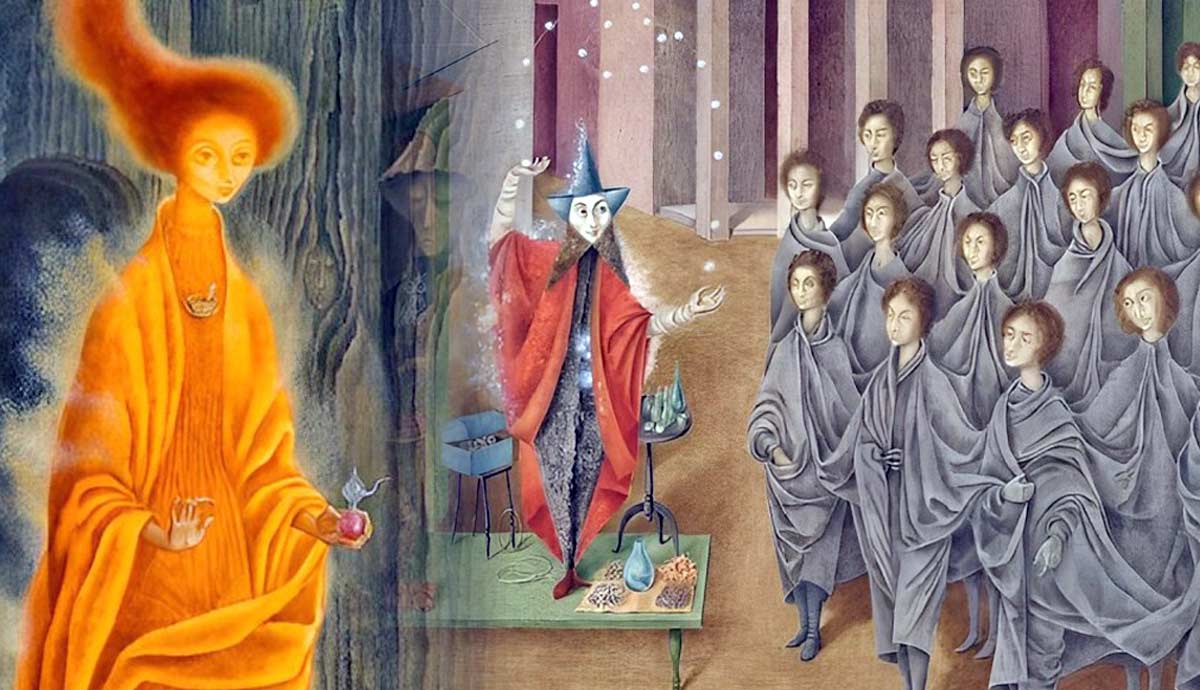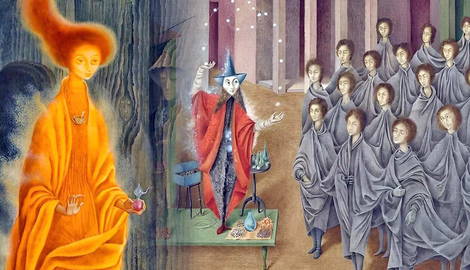
Remedios Varo is a Spanish female Surrealist artist who was active during the first half of the 20th century. Even though she was a prolific painter whose art consisted of multilayered narratives and authentic style, she was overshadowed by her more famous contemporary, Frida Kahlo. Varo explored various surrealist painting techniques and adopted an interdisciplinary approach in her art by combining insights from psychology, religion, and science.
Who Was Remedios Varo?

Remedios Varo is a female Surrealist painter born in Angles, Spain on December 16th, 1908. Although she died at the age of only 53 due to a sudden heart attack, it is estimated that she left approximately 384 artworks behind her. During her early formative years, her father Rodrigo proved to be a supportive and influential figure. He was a hydraulic engineer and Remedios was infatuated with his technical drawings. Motifs such as machinery and hydraulics would show up later in her art. Her father encouraged her to pursue an artistic career, so she enrolled in the School of Fine Arts in Madrid in 1924. There, she was under the guidance of a renowned Spanish painter Manuel Benedito. Varo successfully completed her education in 1930.

After graduating she traveled around Europe. In Barcelona, she formed her first artistic circle of friends which consisted of Oscar Dominguez, a Spanish surrealist painter, and Esteban Frances, a French surrealist and Dadaist poet. Later in Paris Varo met the pioneers of Surrealism like Andre Breton, Leonora Carrington, and Max Ernst. Unfortunately, her artistic development in Europe was disrupted by two major historical events. Firstly, she had to flee from Spain when the Spanish Civil War broke out in 1936, and when it ended in 1939, she was banned from returning by the fascist dictator Francisco Franco. Then, after the beginning of World War II, she found her refuge in Mexico. What was supposed to be a temporary solution turned out to be a permanent one—Remedios Varo spent the last 13 years of her life in Mexico.
Themes of Science and Alchemy

Remedios Varo was influenced by her father’s profession and she showed interest in science from an early age. Since most of Varo’s inspiration stems from her childhood, it is not surprising that themes such as science, physics, and mechanics are an important part of her artwork. The phenomenon of Weightlessness is a powerful example of Varos’ fascination with science. The scene is set in an illogical space where the room is duplicated and positioned at an asymmetrical angle. This aspect emphasizes revelations regarding the relativity of gravity. It is presumed that Albert Einstein and his groundbreaking discovery were used as an inspiration here.

Being a surrealist painter, Varo was naturally drawn to surreal, illogical, and preternatural phenomena. Thus she expressed her interest in alchemy in numerous works. While science was accepted in the real and rational world, alchemy was put aside and labeled as nonsense and borderline witchcraft. But the magical and otherworldly aspects of alchemy found their significant place in Varo’s opus. The Useless Science or The Alchemist encapsulates these qualities. A ghostlike creature, engaged in an enigmatic experiment, is set in a peculiar-looking laboratory. The dominant colors here are also worth noticing. According to alchemistic theories, the colors black, white, yellow, and red allude to the four-stage chemical reaction that produces the elixir of life.
Important Themes: Religion and Psychology

Religion plays a huge part in the artwork of Remedios Varo. Having attended a Catholic convent school as a young girl, she was exposed to strict discipline and dogmatic teaching. This experience fostered her critical thinking and questioning of authority. Consequently, Varo tackled Christianity in a multifaceted manner in her paintings. In her painting called Rupture, the central figure is depicted descending the stairs while leaving behind a stern-looking building with unsmiling guards in it. The main figure with her heart-shaped face, almond eyes, and aquiline nose resembles Varo’s features. Therefore this scene could be interpreted as Varo’s act of cutting ties with the rigidity of religion and tradition. She is off to explore the forbidden domain of magic, alchemy, and even witchcraft.

Just like her fellow Surrealists, Varo expressed interest in psychology and psychoanalysis, especially in Freud’s and Jung’s theories of the subconscious. The central figure in her Woman Leaving the Psychoanalyst resembles the features of Remedios Varo as well. Thus, Varo resonated with the intentions of the depicted woman to explore the unconscious mind and her suppressed desires.
On the other hand, this piece could be analyzed from a feminist perspective. The woman in question is represented holding the head of an old man, getting ready to throw it into a well. This act can be perceived as an act of rebellion. The portrayed woman is ready to reject and free herself from patriarchal notions and limitations symbolized by the man’s head. Even though Varo never deliberately addressed problems of gender inequality, her art showed empowered women. By giving female bodies androgynous forms, Varo freed women from being objectified.
Surrealist Techniques Used by Remedios Varo

Surrealist artists loved to experiment with untraditional techniques, and Remedios Varo was no exception. Even though she predominantly produced oil paintings, she found a way to incorporate unorthodox methods in her art. Interested in automatism and freeing her imagination of conscious control, Varo used techniques such as decalcomania, grattage, and soufflage.
Decalcomania is a surrealist painting technique characterized by the application of one material (e.g. paper, aluminum foil, or glass) to a freshly painted surface followed by peeling it off. The process results in unpredictable and spontaneous patterns. The accidental nature of this technique is closely linked to Varo’s exploration of the subconscious and imagination. Using this method in The Star Catcher she created a biomorphic pattern visible on the garment of the protagonist and on a part of the background.

Most likely invented by Max Ernst, the technique of grattage provides unexpected and chance-driven results. Varo employed grattage in her painting The Escape, which is most evident in the detail of rocks. She scraped the surface with a sharp-edged tool while the paint was still wet. This led to the revealing of underlying layers of paint, which in turn created textured and unpredictable patterns. Therefore, this method provides a dynamic interplay between control and chance.

Soufflage is one of the surrealist painting techniques discovered by the painter Jimmy Ernst. In this method, the artist applies paint in very thin and fluid layers and then blows air (often through a straw) in order to disperse and manipulate the wet material, resulting in ethereal and delicate patterns. Varo used soufflage for the creation of the lower part of the magician’s robe in her painting The Juggler.
The Three Witches and Other Collaborations

Remedios Varo collaborated with many other Surrealist artists, including the British artist Leonora Carrington and the Hungarian artist Kati Horna. Since all three of them found their new home in Mexico, they formed a close friendship. Due to their shared interest in spiritual practices and the occult, they earned the nickname the three witches among their friends and colleagues. The trio wrote two unpublished plays El Santo Cuerpo Grasoso and Lady Milagra. They employed a writing technique similar to the method of cadavre exquis where they took turns in adding small fragments of text. Fascinated by witchcraft, the three of them also undertook the task of writing magical recipes in order to provoke specific dreams.

Remedios Varo worked with other artists as well. She participated in a collaborative work called Game of Communicated Drawing with Robert Rius, Benjamin Peret, and Andre Breton. This series had a game-like nature. Each participant was shown a drawing for three seconds, after which they had to recreate what they had seen.
Varo also took part in a Surrealist game cadavre exquis (or exquisite corpse) with Esteban Frances, Marcel Jean, and Oscar Dominguez. The game involved multiple participants who each contributed to a collective composition without previous knowledge of what others had drawn or written. This method was supposed to encourage the subconscious association of the participants.
What Makes Remedios Varo Important?

Remedios Varo is a vital representative of Surrealism. Her art is complex on many levels. Firstly, she developed a distinctive and original artistic style within the Surrealist movement. Dreamlike creatures that populate mysterious places and engage in mystical and other-worldly activities are a trademark of Varo’s artwork. Furthermore, Varo proved to be well-versed in numerous fields like science, alchemy, psychology, and religion. That comprehensive knowledge gave her artworks multilayered meanings. Finally, Varo collaborated and interacted with prominent Surrealist figures.
Varo’s art is also of crucial importance when it comes to gender studies and feminist theories. Even though she did not declare herself a feminist or address gender inequality in her work, the way Varo depicted women undermined traditional patriarchal values. Her paintings often feature strong and independent female figures undertaking roles that were commonly perceived as masculine. Moreover, Varo never objectified the women she portrayed. Her female characters had depth, intellect, and creativity.
In the end, thanks to Remedios Varo we can conclude that there are always new and lesser-known female artists just waiting to be discovered. Frida Kahlo has become an absolute symbol of female Surrealist art to such an extent that other women artists have been set aside. Therefore, more room needs to be made for different and not-so-popular women artists. Remedios Varo serves as an exemplar highlighting the growing need for art history articles, blogs, and media that amplify the visibility of women in art.










